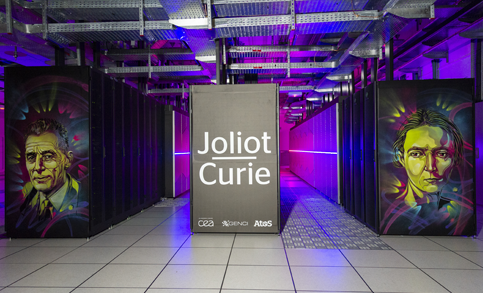Joliot-Curie
One of the most powerful supercomputer dedicated to French and European research
The Joliot-Curie supercomputer was installed at the end of 2017 in the CEA's Very Large Computing Center (TGCC), located in Bruyères-le-Châtel (Essonne), following a purchasing procedure carried out by a team integrated GENCI-CEA. The implementation of Joliot-Curie within the TGCC, as well as its operation, have been entrusted to the operational teams of the CEA's Military Applications Division (DAM). It thus benefits from a cutting-edge scientific and technical environment.
With a processing capacity of 22 petaflops, Joliot-Curie is at the service of French and European researchers, through the European PRACE research infrastructure.

Access to Joliot Curie
 Joliot Curie software environment 2022
Joliot Curie software environment 2022 Main partitions
The first phase of the supercomputer is composed of Bull Sequana X1000 cells with a peak power of ~ 9 Pflops composed by the following partitions :
-
1,656 dual-processor Intel Skylake 8168 fine nodes at 2.7 GHz with 24 cores per processor, for a total of 79,488 computing cores and a power of 6.86 Pflop/s,
-
192 GB of DDR4 memory/node,
-
Infiniband EDR interconnect network.
-
828 Intel KNL 7250 manycore nodes at 1.4 GHz with 68 cores per processor, for a total of 56,304 cores and a power of 2 Pflop/s,
-
96 GB of DDR4 memory + 16 GB of MCDRAM memory/node,
-
Bull eXascale Interconnect network (BXI).
Since the end of 2019, a second phase composed of Bull Sequana XH2000 cells adds the following partitions :
-
2292 dual-processor AMD Rome (Epyc) compute nodes at 2.6 GHz with 64 cores per processor, for a total of 293,376 computing cores and a power of 11.75 Pflop/s,
-
256 GB DDR4 memory/node,
-
Infiniband HDR100 interconnect network.
-
32 hybrid nodes with 2 Intel CascadeLake 20-cores 2.1 GHz processors and 4 NVIDIA V100 GPUs per node, for a total of 128 GPUs and a power of 1.13 PFlop/s.
As part of the Fenix project, the following partitions are also available :
-
30 hybrid nodes with 2 Intel CascadeLake 18-cores 2.6 GHz processors and 1 NVIDIA V100 GPU per node,
-
2 hybrid nodes with 4 Intel CascadeLake 18-cores 2.6 GHz processors, 3 To memory and 1 NVIDIA V100 GPU per node.
Common resources :
-
Irene hybrid : 20 vizualisation nodes with NVIDIA-P100 co-processors,
-
Irene xlarge : 5 so-called big memory/nodes for pre/post processing with 3 TB of memory/node and an NVIDIA-P100 co-processor,
-
A local storage, Scratch type, of 5 PB with a bandwidth of 300 GB/s.
Exploratory partition - ARM :
-
Based on Fujitsu PRIMEHPC FX700 technology : 80 DDR-less single-socket A64FX compute nodes (https://www.genci.fr/fr/node/1076).
Quantum resources
TGCC aims to host quantum computing resources.
Emulators based on the software suites Qaptiva/EVIDEN, Pulser/PASQAL and Perceval/Quandela are already available to end users.
A PASQAL quantum computer, with a hundred of qubits, will be available in Spring 2024.
Joliot-Curie in video
Joliot-Curie June 2019 (in french)
Street art with C215 in a computing room, a first world artistic performance (in french).
